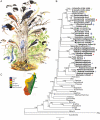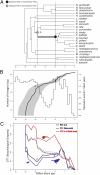Ecological and evolutionary determinants for the adaptive radiation of the Madagascan vangas
- PMID: 22505736
- PMCID: PMC3340096
- DOI: 10.1073/pnas.1115835109
Ecological and evolutionary determinants for the adaptive radiation of the Madagascan vangas
Abstract
Adaptive radiation is the rapid diversification of a single lineage into many species that inhabit a variety of environments or use a variety of resources and differ in traits required to exploit these. Why some lineages undergo adaptive radiation is not well-understood, but filling unoccupied ecological space appears to be a common feature. We construct a complete, dated, species-level phylogeny of the endemic Vangidae of Madagascar. This passerine bird radiation represents a classic, but poorly known, avian adaptive radiation. Our results reveal an initial rapid increase in evolutionary lineages and diversification in morphospace after colonizing Madagascar in the late Oligocene some 25 Mya. A subsequent key innovation involving unique bill morphology was associated with a second increase in diversification rates about 10 Mya. The volume of morphospace occupied by contemporary Madagascan vangas is in many aspects as large (shape variation)--or even larger (size variation)--as that of other better-known avian adaptive radiations, including the much younger Galapagos Darwin's finches and Hawaiian honeycreepers. Morphological space bears a close relationship to diet, substrate use, and foraging movements, and thus our results demonstrate the great extent of the evolutionary diversification of the Madagascan vangas.
Conflict of interest statement
The authors declare no conflict of interest.
Figures



References
-
- Osborn HF. The law of adaptive radiation. Am Nat. 1902;36:353–363.
-
- Simpson GG. The Major Features of Evolution. New York: Columbia Univ Press; 1953.
-
- Givnish TJ. In: Molecular Evolution and Adaptive Radiation. Givnish TJ, Sytsma KJ, editors. Cambridge, UK: Cambridge Univ Press; 1997. pp. 1–54.
-
- Schluter D. The Ecology of Adaptive Radiation. Oxford: Oxford Univ Press; 2000.
-
- Grant PR, Grant BR. How and Why Species Multiply: The Radiation of Darwin's Finches. Princeton, NJ: Princeton Univ Press; 2008.
Publication types
MeSH terms
Associated data
- Actions
- Actions
- Actions
- Actions
- Actions
- Actions
- Actions
- Actions
- Actions
- Actions
- Actions
- Actions
- Actions
- Actions
- Actions
- Actions
- Actions
- Actions
- Actions
- Actions
- Actions
- Actions
- Actions
- Actions
- Actions
- Actions
- Actions
- Actions
- Actions
- Actions
- Actions
- Actions
- Actions
- Actions
- Actions
- Actions
- Actions
- Actions
- Actions
- Actions
- Actions
- Actions
- Actions
- Actions
- Actions
- Actions
- Actions
- Actions
- Actions
- Actions
- Actions
- Actions
- Actions
- Actions
- Actions
- Actions
- Actions
- Actions
- Actions
- Actions
- Actions
- Actions
- Actions
- Actions
- Actions
- Actions
- Actions
- Actions
- Actions
- Actions
- Actions
- Actions
- Actions
- Actions
- Actions
- Actions
- Actions
- Actions
- Actions
- Actions
- Actions
- Actions
- Actions
- Actions
- Actions
- Actions
- Actions
- Actions
- Actions
- Actions
- Actions
- Actions
- Actions
- Actions
- Actions
- Actions
- Actions
- Actions
- Actions
- Actions
- Actions
- Actions
- Actions
- Actions
- Actions
- Actions
- Actions
- Actions
- Actions
- Actions
- Actions
- Actions
- Actions
- Actions
- Actions
- Actions
- Actions
- Actions
- Actions
- Actions
- Actions
- Actions
- Actions
- Actions
- Actions
- Actions
- Actions
- Actions
- Actions
- Actions
- Actions
- Actions
- Actions
- Actions
- Actions
- Actions
- Actions
- Actions
- Actions
- Actions
- Actions
- Actions
- Actions
- Actions
- Actions
- Actions
- Actions
- Actions
- Actions
- Actions
- Actions
- Actions
- Actions
- Actions
- Actions
- Actions
- Actions
- Actions
- Actions
- Actions
- Actions
- Actions
- Actions
- Actions
- Actions
- Actions
- Actions
- Actions
- Actions
- Actions
LinkOut - more resources
Full Text Sources
Other Literature Sources

